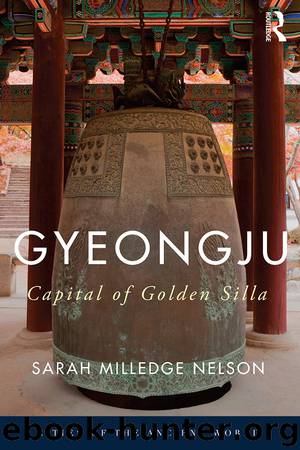Gyeongju by Nelson Sarah Milledge;

Author:Nelson, Sarah Milledge;
Language: eng
Format: epub
Publisher: Routledge
Published: 2017-02-08T16:00:00+00:00
Bone is the Korean metaphor for genetic relationships, instead of blood, as in English one would speak of “blood” kinship. In Ancient Silla (Go Silla) the highest rank was called Song’gol, “Holy Bone” or “Sacred Bone,” and only those whose parents were both Holy Bone were eligible to be kings and queens (Grayson 1976; Kim Chong Sun 1977). It is important to note that, “The holders of the highest status, Song’gol, were eligible for the throne, regardless of sex” (Kim Chong Sun 1977:47), which made Silla distinct from other Korean polities of the time, but with similarities to Yamato in the Kogun Period (Piggott 1997).
The bone ranks were at the same time social, economic, and political (Grayson 1976; Kim Chong Sun 1977; Nelson 1991, 1993a, 2003; Sasse 2001). The highest rank of Song’gol conferred eligibility to rule. Birth into the Sacred Bone rank did not specifically confer the rulership, it only allowed a person to be in the pool from which rulers could be chosen. The ruler was selected by a council of Sacred Bone (Kim Chong Sun 1969) from among its own rank.
A rule of hypodescent has been inferred from the list of rulers, which includes the names of the ruler’s parents, their spouses, and their spouses’ parents. It seems that no one could belong to the rank of Holy Bone unless both parents were from that rank, and a person took the rank of the lower ranking parent (Grayson 1976; Sasse 2001). In their official roles, people of the Holy Bone rank were distinguished by purple robes. This seems relevant to some otherwise mysterious prohibition of purple clothing or objects. Even the True Bone were not allowed to display anything purple or even purplish.
The second rank was Chin’gol, “True Bone.” True Bone were high nobles, but True Bone persons only became eligible to rule after the pure Song’gol rank had died out. Two successive queens were the last survivors of the Holy Bone rank. Below the two highest noble ranks were the Ryuktupum, the Odupum, and the Sadupum (“Sixth,” “Fifth,” and “Fourth” Head ranks, respectively). Everyone below the Sixth to Fourth Head ranks was a commoner, ineligible to serve in the court. The Fourth Head rank was sometimes grouped with commoners in the list of rules.
Download
This site does not store any files on its server. We only index and link to content provided by other sites. Please contact the content providers to delete copyright contents if any and email us, we'll remove relevant links or contents immediately.
| Anthropology | Archaeology |
| Philosophy | Politics & Government |
| Social Sciences | Sociology |
| Women's Studies |
Mysteries by Colin Wilson(3394)
People of the Earth: An Introduction to World Prehistory by Dr. Brian Fagan & Nadia Durrani(2701)
Ancient Worlds by Michael Scott(2622)
Foreign Devils on the Silk Road: The Search for the Lost Treasures of Central Asia by Peter Hopkirk(2433)
The Splendid and the Vile by Erik Larson(2354)
The Memory Code by Lynne Kelly(2352)
Come, Tell Me How You Live by Mallowan Agatha Christie(2212)
Lost Technologies of Ancient Egypt by Christopher Dunn(2194)
The Earth Chronicles Handbook by Zecharia Sitchin(2179)
The Plantagenets by Dan Jones(2038)
Last Chance to See by Douglas Adams(1933)
The Return of the Gods by Erich von Daniken(1895)
Wars of the Anunnaki by Chris H. Hardy(1681)
Keeper of Genesis by Graham Hancock(1607)
Before the Dawn by Nicholas Wade(1575)
The Cygnus Mystery by Andrew Collins(1520)
The Message of the Sphinx by Graham Hancock(1482)
Fragile Lives by Stephen Westaby(1421)
Hieroglyphs: A Very Short Introduction by Penelope Wilson(1312)
